Earnings Beat: Workday, Inc. Just Beat Analyst Forecasts, And Analysts Have Been Updating Their Models
It's been a mediocre week for Workday, Inc. (NASDAQ:WDAY) shareholders, with the stock dropping 14% to US$221 in the week since its latest quarterly results. It looks like a credible result overall - although revenues of US$2.0b were what the analysts expected, Workday surprised by delivering a (statutory) profit of US$0.40 per share, an impressive 43% above what was forecast. The analysts typically update their forecasts at each earnings report, and we can judge from their estimates whether their view of the company has changed or if there are any new concerns to be aware of. With this in mind, we've gathered the latest statutory forecasts to see what the analysts are expecting for next year.
Check out our latest analysis for Workday
Taking into account the latest results, the most recent consensus for Workday from 36 analysts is for revenues of US$8.38b in 2025. If met, it would imply a solid 11% increase on its revenue over the past 12 months. Statutory earnings per share are expected to plunge 70% to US$1.68 in the same period. Before this earnings report, the analysts had been forecasting revenues of US$8.40b and earnings per share (EPS) of US$1.79 in 2025. The analysts seem to have become a little more negative on the business after the latest results, given the minor downgrade to their earnings per share numbers for next year.
The average price target fell 7.7% to US$289, with reduced earnings forecasts clearly tied to a lower valuation estimate. It could also be instructive to look at the range of analyst estimates, to evaluate how different the outlier opinions are from the mean. The most optimistic Workday analyst has a price target of US$350 per share, while the most pessimistic values it at US$190. As you can see, analysts are not all in agreement on the stock's future, but the range of estimates is still reasonably narrow, which could suggest that the outcome is not totally unpredictable.
Taking a look at the bigger picture now, one of the ways we can understand these forecasts is to see how they compare to both past performance and industry growth estimates. The period to the end of 2025 brings more of the same, according to the analysts, with revenue forecast to display 15% growth on an annualised basis. That is in line with its 18% annual growth over the past five years. Juxtapose this against our data, which suggests that other companies (with analyst coverage) in the industry are forecast to see their revenues grow 13% per year. It's clear that while Workday's revenue growth is expected to continue on its current trajectory, it's only expected to grow in line with the industry itself.
The Bottom Line
The biggest concern is that the analysts reduced their earnings per share estimates, suggesting business headwinds could lay ahead for Workday. They also reconfirmed their revenue estimates, with the company predicted to grow at about the same rate as the wider industry. The consensus price target fell measurably, with the analysts seemingly not reassured by the latest results, leading to a lower estimate of Workday's future valuation.
With that said, the long-term trajectory of the company's earnings is a lot more important than next year. At Simply Wall St, we have a full range of analyst estimates for Workday going out to 2027, and you can see them free on our platform here..
Another thing to consider is whether management and directors have been buying or selling stock recently. We provide an overview of all open market stock trades for the last twelve months on our platform, here.
Have feedback on this article? Concerned about the content? Get in touch with us directly. Alternatively, email editorial-team (at) simplywallst.com.
This article by Simply Wall St is general in nature. We provide commentary based on historical data and analyst forecasts only using an unbiased methodology and our articles are not intended to be financial advice. It does not constitute a recommendation to buy or sell any stock, and does not take account of your objectives, or your financial situation. We aim to bring you long-term focused analysis driven by fundamental data. Note that our analysis may not factor in the latest price-sensitive company announcements or qualitative material. Simply Wall St has no position in any stocks mentioned.

 Yahoo Finance
Yahoo Finance 
